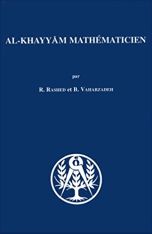Omar Khayyam. Keene, H.G. MacMillans’s Magazine, 57 (1887) (Apr.), pp. 27-32.
Archives
Omar Khayyam, the astronomer-poet of Persia
Omar Khayyam, the astronomer-poet of Persia. Cowell, Edward Byles. Calcutta Review, (1858), 59, pp. 149-162.
Al-Khayyám mathématicien
Al-Khayyám mathématicien. Rashed, R. et B. Vahabzadeh. Paris, Librairie Scientifique et technique A. Blanchard, 1999. x, 428 p. ISBN: 2853672107
Summary:
Personnage de légende, ‘Umar al-Khayyam (1048-1131) est aussi un mathématicien novateur et un éminent philosophe. Il fut le premier à concevoir la géométrie algébrique, développée par son successeur Sharaf al-Din al-Tùsi puis, six siècles plus tard, par Descartes et Fermat. Critique de la théorie des parallèles d’Euclide aussi bien que de sa théorie des proportions, il imprègne l’histoire de ces théories, et inspire les mathématiciens jusqu’à Wallis et Saccheri. Dans ce livre sont pour la première fois réunis tous les écrits mathématiques d’al-Khayyàm, scientifiquement établis et rigoureusement traduits ; ils sont précédés des commentaires historiques et mathématiques nécessaires à l’intelligence de leur auteur, et qui placeront son œuvre dans l’histoire des mathématiques.
Edward FitzGerald’s Translation of The Rubáiyát of Omar Khayyám
Edward FitzGerald’s Translation of The Rubáiyát of Omar Khayyám: The Appeal of Terse Hedonism. Asghar Seyed-Gohrab
In: Seigneurie (Ed.) 2020 – A Companion to World Literature, Volume 4: 1771 to 1919.
